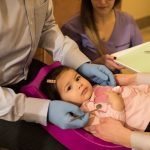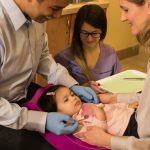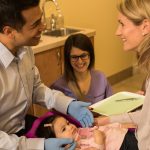Age 1 Dental Exam
First tooth? First Dental Visit
As recommended by the Canadian Pediatric Society, Canadian Dental Association, and the Canadian Academy of Pediatric Dentistry, children should have their first check up 6 months after their first tooth erupts or by their first birthday. Establishing a “dental home” for children at an early age helps to identify early signs of dental decay and prevent dental disease from occurring. Dental decay is one of the most common infectious diseases in children today. At Milton Pediatric Dentistry we are advocates of dental disease prevention and empower parents with the tools to do this by teaching them about prevention at all oral hygiene visits, particularly during the first visit. A questionnaire filled out by parents is reviewed and a “Caries (Cavity) Risk Assessment” is done. This is a well studied and documented tool to predict a child’s risk for cavities based on factors such as family history, diet and oral hygiene practice.
The exam is done while the baby or toddler is in their parent’s lap, either with child in their parent’s lap or via the “knee to knee” exam. This is where the dentist and parent sit knee to knee. In the comfort of the parent’s lap, with our calm and kind approach, and friendly environment, children do very well for their first exam and parents are pleasantly surprised!
Knee-to-knee age 1 exam
- First dental exam for Ava
- Knee-to-knee exam
- Michelle supports baby and parent
- Explaining findings of the exam…Great check up!
Toddler exam in parent’s lap
- Charlotte in Grandma’s lap
What is a Dental Home?
“The dental home is the ongoing relationship between the dentist and the patient, inclusive of all aspects of oral health care delivered in a comprehensive, continuously accessible, coordinated, and family-centered way. Establishment of a dental home begins no later than 12 months of age.”
The Scientific Evidence on the Benefits of the First Dental Visit
The Canadian and American Academies of Pediatric Dentistry, the Canadian Paediatric Society and the American Academy of Pediatrics recommend that all children have their first dental visit during the first year of life. Providing early care to infants and their families allows for an opportunity to educate and inform parents about their children’s oral health. Parents are given counseling about infant oral hygiene, dietary counseling, caries risk assessment, home and office based fluoride therapies, and information relative to oral habits and dental injury prevention.1
Waiting for the first dental visit has many consequences
Dental cavities (caries) in children is the most prevalent disease of childhood, occurring 5 to 8 times more frequently than asthma! 2 National surveys in the US report that 41 % of children 2 to 11 years of age had cavities in their baby teeth and 42 % of children 6 to 19 years of age had cavities in their permanent teeth.3
Serious Health Problems, School Performance
Serious general health problems and significant pain, interference with eating, overuse of emergency rooms, and lost school time can result from cavities in children.7
School aged “children with poor ORAL health status were nearly 3 times more likely than their counterparts to miss school as a result of dental pain.5
Absences caused by pain were associated with poorer school performance however absences for routine check ups and treatment were not associated with poor performance.” Dental disease can also have systemic effects.4
There are several established links that have been found between oral infections caused by cavities and diabetes, heart disease, stroke, pre-term low birth weight babies. In addition to the link between oral and systemic health, oral health strongly influences quality of life and general well-being.
References
1. American Academy of Pediatric Dentistry. Infant Oral Health. Pediatr Dent 2000;22:82.
2. Oral Health in America: A Report of the Surgeon General. Rockville, MD: U.S. Department of Health and Human Services, National Institute of Dental and Craniofacial Research, National Institutes of Health; 2000.
3. Beltran-Aguilar ED, Barker LK, Canto MT, et al. Surveillance for dental caries, dental sealants, tooth retention, edentulism, and enamel fluorosis. MMWR Surveillance Summaries. 2005;54(3):1-44.
4. Edelstein BL, Maiorini E, Casamassimo PS, and Thikkurissy S, Beyond the dmft: The Human and Economic Cost of Early Childhood Caries J Am Dent Assoc 2009;140(6):650-657
5. Jackson SL, Vann WF Jr., Pahel BT, Kotch JB, Lee JY. The Impact of Poor Oral Health on Children’s School Performance Am J Pub Health 2011; February 17: e1-e7. doi:10.2105/ AJPH. 2010.200915.







